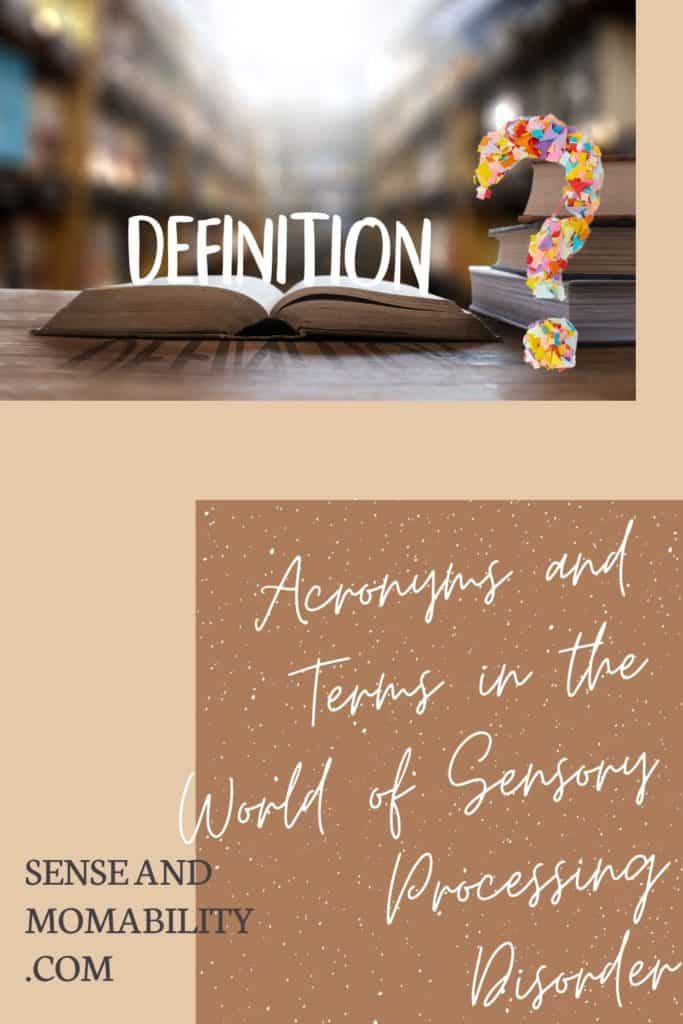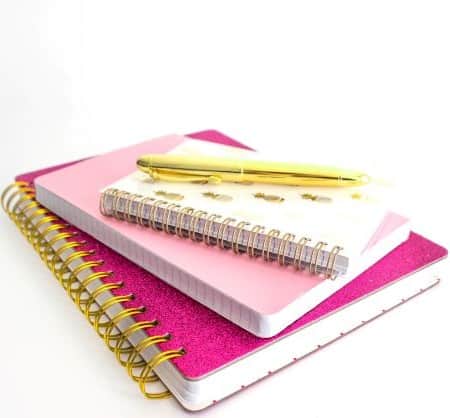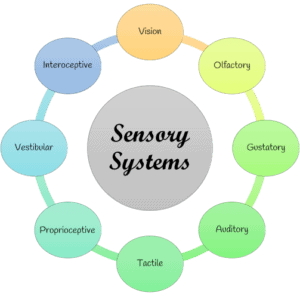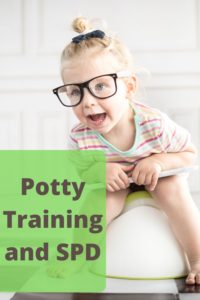The world is full of acronyms. Remember when LOL, ROTFL, and BRB were the hot lingo, and our parents were just clueless?
Welcome to the world of Sensory Processing Disorder where everything is made up and the points don’t matter.
Wait, no, wrong topic. Back to SPD.
There are so many terms, acronyms, and resources out there for parents of children with SPD. This is a simple (ever changing) glossary. Some are not typically used anymore, but are included for reference. Please note – these are arranged in category *then* alphabetical order.
Category 1: Disorders, etc.
ADD / ADHD or ADHA – Attention Deficit Disorder / Attention Deficit Hyperactivity Disorder
ADD is a neurological disorder that causes issues with attention, memory, impulsivity. In the DSM, it is divided into 3 types – ADHD predominantly inattentive presentation, ADHD predominantly hyperactive-impulsive presentation, and ADHD combined presentation.
AS – Asperger Syndrome
This is a developmental disorder, no longer diagnosed as separate from Autism Spectrum Disorder. Generally, it was diagnosed in individuals who had no intellectual or speech delay but had difficulty understanding social cues.
ASD – Autism Spectrum Disorder
This is a developmental disorder that can cause social difficulties, speech delays, behavioral concerns, and problems processing sensory information. Please note that while individuals with ASD *usually* have SPD, those with SPD sometimes have ASD. If your child has sensory processing difficulties, he or she may not have autism.
DD / ID / MR – Developmental Disabilities / Intellectual Disabilities / Mental Retardation
Intellectual disability (formerly mental retardation) is diagnosed through the criteria of have deficits in intellectual function as well as adaptive functioning. An IQ score of 70 or below is typically the threshold. Adaptive functioning refers to how the individual communicates, socializes, functions at school or work, and takes care of him or herself (bathes, cooks, accesses the community, etc.) Lastly, to be diagnosed with Intellectual Disability, the person must show limitations in the above during childhood and adolescence. An acquired disability in adulthood with the above functioning concerns would be neurocognitive disorder.
DSM – Diagnostic and Statistical Manual of Mental Disorders
This is the manual that defines and classifies mental disorders. The current manual is version 5 and was released in 2013. The first was released in 1952.
EFDD – Executive Function Deficit Disorder
This is a non-DSM disorder, related to ADD. A person with executive function difficulties have trouble organizing and regulating their behavior.
NT – Neurotypical
This term generally refers to an individual that does not have autism or sensory disorders.
OCD – Obsessive Compulsive Disorder
This is a mental (anxiety) disorder characterized by obsessions (intrusive thoughts that cause stress) and compulsions (the need to do a certain behavior, usually multiple times). It can be connected to sensory processing issues.
SID – Sensory Integration Dysfunction
This is the former term for SPD.
SPD – Sensory Processing Disorder
This is a somewhat recognized disorder in which sensory signals are not received and organized correctly. It is often seen as a characteristic of autism, though individuals not on the spectrum are informally diagnosed with just SPD as well. This disorder is not formally recognized by most psychiatrists or the DSM-5. Please note that while individuals with ASD *usually* have SPD, those with SPD *sometimes* have ASD. If your child has sensory processing difficulties, he or she may not have autism.
Category 2: Therapies, Devices, etc.
ABA – Applied Behavior Analysis
ABA is a type of therapy, commonly used to help children with autism learn in a one on one setting. A BCBA works with the family to develop goals and then the RBT implements them. Things like social skills, language, reading, self-care, and fine motor can be taught using this tactic. It is under the umbrella of behavioral psychology. ABA is a controversial topic – while the therapy has benefited families, many autistic adults have come out against ABA as an abusive form of therapy. ABA continues to be a growing and changing therapy, with a great deal of variance across companies, BCBAs, and technicians.
Note: BCBA – A Board Certified Behavior Analyst is a person with certification in ABA. A graduate degree is required.
RBT – A Registered Behavior Technician is a paraprofessional certificate for ABA. To qualify, a person must have a high school diploma or equivalent. It requires a competency assessment following training.
AAC – Assistive Augmentative Communication
This term refers to any alternative (non-speech) method to help a person communicate. This can be sign language, picture cards, voice output switches, communication devices or AAC apps on tablets, and even body language.
DI Therapy/DT – Developmental Intervention Therapy / Developmental Therapist
A developmental therapist is a unique therapist that can help in Early Intervention and beyond. This person would design and implement interventions for your child and family in your everyday life.
EI – Early Intervention
Early Intervention is a support provided to young children, ages 0-3 with delays in development. It is publicly funded at no to low cost to families who require services.
IFSP – Individualized Family Service Plan
This is a document that specifies the needs and services provided in Early Intervention. A big focus of the IFSP (as shown in the title) is the family as a whole.
IPP – Individual Program Plan or similar
This term tends to be organization specific. It is an annual document focused on the person. It should include details about the person, his or her interests, therapies and evaluations, a review of the previous year, and what goals the person will work on over the next year.
OT – Occupational Therapy / Occupational Therapist
The occupational therapist can also have my specialties. She can be a hugely beneficial resource for your child with sensory needs. The OT may work not only with fine motor development but sensory concerns as well. In children, a great deal of an OT session may look like “play” (and feel like it to your child!) but a lot of learning is going on! The OT may also specialize in oral motor concerns.
PECS – Picture Exchange Communication System
PECS is an assistive augmentative communication system designed to help people with no or limited speech communicate. It is picture based.
PT – Physical Therapy / Physical Therapist
A physical therapist can have many specialties, including rehabilitation after accidents. As it relates to this blog, physical therapy refers to therapy dealing with the gross motor development of a child. He may work on sitting up, walking up stairs, and accessing a playground!
ST / SLP – Speech Therapy / Speech Language Pathologist
Again – lots of specialties. An SLP focuses on communication. She may help your child with receptive (understanding what others say) as well as expressive language. She As with OT, an SLP may also have the oral-motor specialty – this would be especially beneficial if there is a physical reason your child is unable to speak on par developmentally.
Category 3: Laws, Education, etc.
ADA – Americans with Disabilities Act
This is a civil rights law, signed in 1990 that prohibits discrimination against people with disabilities in jobs, education, transportation, and general public access.
IDEA – Individuals with Disabilities Education Act
This is an American Federal Law which ensures that students with disabilities are provided with Free Appropriate Public Education that is personalized to their specific needs. There have been many court cases and legislation that have led to what we currently have legally. In 1975, the “Education for All Handicapped Children Act” was signed into law by President Ford, which basically said that states that received federal funding for education were mandated to provide equal access to education for children with disabilities. It has gone through changes, becoming IDEA in 1997 under President Clinton.
IEP – Individualized Education Plan
The IEP is a legal document for children in public schools who require special education. The “team” (family, therapists, teacher, psychologist, etc) create the document. It includes therapy evaluations and skills the child will be working on. It also details what accommodations the child requires to access the educational environment.






Pingback: Sides of the IEP Table - Are My Feelings Valid? - Sense and MomAbility
Such a helpful resource.
Pingback: Fantastic Products for Oral Sensory Seekers - Sense and MomAbility
Pingback: Your Family and Covid-19 - Sense and MomAbility
Pingback: Reducing or Eliminating Services? - Sense and MomAbility
Pingback: Effective Proprioceptive Activities PLUS Signs They Are Needed! - Sense and MomAbility
Thanks for sharing! It is good to spread this info, l learned much.
Pingback: Should you have another child? - Sense and MomAbility
Together For Better Therapy offers Applied Behaviour Analysis (ABA) interventions and Speech Therapy to children in the Durham Region and the Greater Toronto Area (GTA) who have Autism, social communication disorder etc.